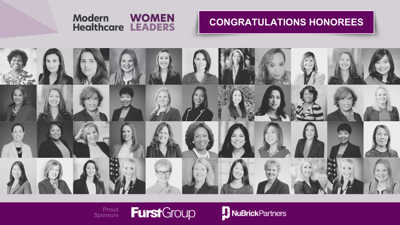As the oldest daughter in a large family, Patricia Maryland, Dr.PH, was often left in charge when her mother was hospitalized during a years-long struggle with Type 2 diabetes.
One in a series of interviews with Modern Healthcare's Top 25 Women in Healthcare for 2015.
As the oldest daughter in a large family, Patricia Maryland, Dr.PH, was often left in charge when her mother was hospitalized during a years-long struggle with Type 2 diabetes. Her mother eventually died of complications from the condition, and Maryland recalls her frustration with the fragmented healthcare system in which they found themselves.
“We didn’t understand at that time she needed more than general primary care,” she says. “Someone should have been helping us navigate her care to the appropriate subspecialist and other support systems as her condition continued to worsen.”
Unfortunately, similar stories have played out within hospitals and health systems across the United States.
As president of healthcare operations and chief operating officer of Ascension Health, a subsidiary of Ascension, Maryland is committed to leading change – knowing from experience the great need for personalized, coordinated care in this ever-changing healthcare environment.
“I think we can do a better job in healthcare,” says Maryland. “The time has come for us to turn the process upside down – or should I say right-side up – organizing the providers around the needs of the patients, not expecting the patients to figure where to go in our complicated health systems to get the care they need at the convenience of the providers.”
As the world’s largest Catholic health system, Ascension’s mission is steeped in delivering spiritually-centered, holistic care to all with special attention to those who are poor and vulnerable. Maryland makes a point of saying that all healthcare leadership should approach the business of healthcare from a similar perspective.
“Without passion for why we are here and what we are trying to do, we will not be able to be the transformational leaders that healthcare needs today.”
That passion has not dampened her business objectivity, however. Quite the contrary. Maryland’s passion is paralleled only by her dedication to analytics, cultivated through her master’s degree in biostatistics and doctorate in public health.
Maryland explained that biostatisticians tend to work in pharmaceutical industries or medical research areas, with a focus is on efficacy, research, precision and statistical analysis. However, she believes that in today’s health industry, metrics are essential for all healthcare leaders.
“Data analysis is the lifeline of any business, particularly a healthcare organization,” she says. “It is vital that we maintain clear and measurable data so that we can address opportunities for improvement that would not be realized otherwise. By tracking trends, Ascension analyzes where we need to go and what decisions we need to make on any given initiative.”
Maryland says statistics are especially crucial as the roles of payers and providers overlap and converge.
“As we think about population health management and the direction that the health industry is moving, analytics and the ability to predict outcomes using data is so important,” she says. “Predictive analytics have helped us manage risk.”
Her background has come in handy as Ascension has moved boldly into this new era of providers taking on risk. She was one of the architects of Together Health Network (THN), formed by partnering with Trinity Health, another Catholic system, to create a physician-led, clinically integrated network in the state of Michigan. THN worked with Blue Cross Blue Shield of Michigan to create Connected Care, a Medicare Advantage product that rolled out in January 2015 and already has surpassed enrollment projections.
“We are especially attractive to payers because our organizations – both Trinity and Ascension – have some of the best metrics in the state,” Maryland says. “We are able to offer the value combination of high quality and low cost to major payers, and to take on and manage their members with a level of consistency.”
With Ascension operating in 23 states as well as the District of Columbia, the THN experience has been a strong test run to for the organization in developing comprehensive, integrated systems of care. It’s also working to round out other parts of the care continuum – including senior care and home care – so it can better serve its communities.
Ascension also has taken the plunge into insurance. The system acquired U.S. Health and Life Insurance Co. last December and is using that platform as well as MissionPoint Health Partners, its population-health management company, to develop benefits and gain experience by managing the quality and cost of care for Ascension’s own associates and their dependents. In essence, it has become its own incubator for development of an insurance product for self-insured employers.
“We are going to pilot it first with our own employees,” Maryland says. “Once we have a proven track record with our associates, we’ll take it to market. How do we go anywhere else and offer the product unless we ourselves can say, ‘Look at our results.’ This is also why data is so important. We believe we have the best practices, and with this data we will be able to demonstrate it.”
From new partners to new products, healthcare’s future looks a lot different than it did just a few short years ago. Yet despite the changes in how her system and the industry operate, she says the fundamentals are the same. After all, as Maryland knows, healthcare is deeply personal.
“Considering Ascension’s scale and scope, we asked ourselves, ‘If not us, then who?’ We are committed to leading change in the healthcare arena,” she says. “Through standardizing and connecting once disparate systems, we remain true to our Mission of delivering compassionate, personalized care to those who need it the most.”


